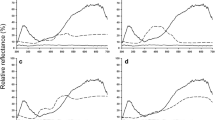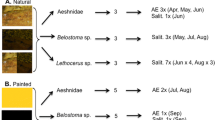Abstract
Bright colorations in animals are sometimes an antipredatory signal meant to startle, warn, or deter a predator from consuming a prey organism. Freshwater turtle hatchlings of many species have bright ventral coloration with high internal contrast that may have an antipredator function. We used visual modeling and field experiments to test whether the plastron coloration of Chrysemys picta hatchlings deters predators. We found that bird predators can easily distinguish hatchling turtles from their backgrounds and can easily see color contrast within the plastron. Raccoons cannot easily discriminate within-plastron color contrast but can see hatchlings against common backgrounds. Despite this, we found that brightly-colored, high contrast, replica turtles were not attacked less than low contrast replica turtles, suggesting that the bright coloration is not likely to serve an antipredatory function in this context. We discuss the apparent lack of innate avoidance of orange coloration in freshwater turtles by predators and suggest that preference and avoidance of colors are context-dependent. Since the bright colors are likely not a signal, we hypothesize that the colors may be caused by pigments deposited in tissue from maternal reserves during development. In most species, these pigments fade ontogenetically but they may have important physiological functions in species that maintain the bright coloration throughout adulthood.





Similar content being viewed by others
References
Blount J, Surai P, Houston D, Møller A (2002) Patterns of yolk enrichment with dietary carotenoids in gulls: the roles of pigment acquisition and utilization. Funct Ecol 16:445–453
Brainard G, Barker F, Hoffman R, Stetson M, Hanifin J, Podolin P, Rollag M (1994) Ultraviolet regulation of neuroendocrine and circadian physiology in rodents. Vis Res 34:1521–1533
Britson CA (1996) Predatory responses of largemouth bass (Micropterus salmoides) to conspicuous and cryptic hatchling turtles: comparative and manipulative experiments. In: Behavioral defenses associated with plastral coloration in hatchling, freshwater turtles. University of Memphis, unpublished dissertation
Britson CA, Gutzke WH (1993) Antipredator mechanisms of hatchling freshwater turtles. Copeia 1993:435–440
Campbell HW, Evans WE (1972) Observations on the vocal behavior of chelonians. Herpetologica 28:277–280
Costantini D, Fanfani A, Dell’Omo G (2008) Effects of corticosteroids on oxidative damage and circulating carotenoids in captive adult kestrels (Falco tinnunculus). J Comp Physiol B 178:829–835
Edmunds M (1974) Defence in animals: a survey of anti-predator defences. Longman Publishing Group, London
El-Agamey A, Lowe GM, McGarvey DJ, Mortensen A, Phillip DM, Truscott TG, Young AJ (2004) Carotenoid radical chemistry and antioxidant/pro-oxidant properties. Arch Biochem Biophys 430:37–48
Endler JA (1992) Signals, signal conditions, and the direction of evolution. Am Nat 139:S125–S153
Endler JA, Mielke PW (2005) Comparing entire colour patterns as birds see them. Biol J Linn Soc 86:405–431
Ernst CH, Lovich JE (2009) Turtles of the United States and Canada. JHU Press, Baltimore, Maryland
Gamberale-Stille G, Tullberg BS (2001) Fruit or aposematic insect? Context-dependent colour preferences in domestic chicks. Proc R Soc Lond B Biol Sci 268:2525–2529
Govardovskii VI, Fyhrquist N, Reuter T, Kuzmin DG, Donner K (2000) In search of the visual pigment template. Vis Neurosci 17:509–528
Grum F, Luckey GW (1968) Optical sphere paint and a working standard of reflectance. Appl Opt 7:2289–2294. doi:10.1364/ao.7.002289
Ham A, Ihalainen E, Lindström L, Mappes J (2006) Does colour matter? The importance of colour in avoidance learning, memorability and generalisation. Behav Ecol Sociobiol 60:482–491
Haq A-U, Bailey CA, Chinnah A (1996) Effect of β-carotene, canthaxanthin, lutein, and vitamin E on neonatal immunity of chicks when supplemented in the broiler breeder diets. Poult Sci 75:1092–1097
Hart NS (2001) Variations in cone photoreceptor abundance and the visual ecology of birds. J Comp Physiol A 187:685–697
Hunt DM, Carvalho LS, Cowing JA, Davies WL (2009) Evolution and spectral tuning of visual pigments in birds and mammals. Philos Trans R Soc B Biol Sci 364:2941–2955
Jacobs GH, Deegan JF II (1992) Cone photopigments in nocturnal and diurnal procyonids. J Comp Physiol A 171:351–358
Joron M (2003) Aposematic coloration. In: Encyclopedia of insects. Academic Press, Elsevier Inc., Burlington, MA, pp 39–45
Karadas F, Pappas AC, Surai PF, Speake BK (2005) Embryonic development within carotenoid-enriched eggs influences the post-hatch carotenoid status of the chicken. Comp Biochem Physiol B Biochem Mol Biol 141:244–251
Kemp DJ, Herberstein ME, Fleishman LJ, Endler JA, Bennett ATD, Dyer AG, Hart NS, Marshall J, Whiting MJ (2015) An integrative framework for the appraisal of coloration in nature. Am Nat 185:705–724. doi:10.1086/681021
Lindström L, Alatalo RV, Mappes J (1999) Reactions of hand-reared and wild-caught predators toward warningly colored, gregarious, and conspicuous prey. Behav Ecol 10:317–322
Maia R, Eliason CM, Bitton PP, Doucet SM, Shawkey MD (2013) pavo: an R package for the analysis, visualization and organization of spectral data. Methods Ecol Evol 4:906–913
Marples N, Kelly D (1999) Neophobia and dietary conservatism: two distinct processes? Evol Ecol 13:641–653
Marples NM, Roper TJ, Harper DG (1998) Responses of wild birds to novel prey: evidence of dietary conservatism. Oikos 83:161–165
McGraw K, Adkins-Regan E, Parker R (2005) Maternally derived carotenoid pigments affect offspring survival, sex ratio, and sexual attractiveness in a colorful songbird. Naturwissenschaften 92:375–380
Ödeen A, Håstad O, Alström P (2010) Evolution of ultraviolet vision in shorebirds (Charadriiformes). Biol Lett 6:370–374
Olsson P, Lind O, Kelber A (2015) Bird colour vision: behavioural thresholds reveal receptor noise. J Exp Biol 218:184–193
Schlenoff DH (1985) The startle responses of blue jays to Catocala (Lepidoptera: Noctuidae) prey models. Anim Behav 33:1057–1067
Schmidt V, Schaefer HM (2004) Unlearned preference for red may facilitate recognition of palatable food in young omnivorous birds. Evol Ecol Res 6:919–925
Schneider JG (1783) Allgemeine Naturgeschichte der Schildkröten: nebst einem systematischen Verzeichnisse der einzelnen Arten und zwei Kupfren. J.G. Müller, Leipzig
Stuart-Fox D, Moussalli A, Whiting MJ (2007) Natural selection on social signals: signal efficacy and the evolution of chameleon display coloration. Am Nat 170:916–930
Umbers KD, Lehtonen J, Mappes J (2015) Deimatic displays. Curr Biol 25:R58–R59
Vorobyev M, Osorio D (1998) Receptor noise as a determinant of colour thresholds. Proc R Soc Lond Ser B Biol Sci 265:351–358
Weisrock D, Janzen F (1999) Thermal and fitness-related consequences of nest location in painted turtles (Chrysemys picta). Funct Ecol 13:94–101
Acknowledgements
The authors would like to thank Rebecca and Rick Nelson, Gary and Linda Pulford, and Willem Roosenberg and his field team for their significant contributions to hatchling collection efforts. They would also like to thank T. Nelson, J. Murphy, M. Pardue, M. C. Duryea, N. Hess, A. Edsor, K. Smith, and A. Formby. This project was funded by a National Science Foundation East Asia and Pacific Summer Institute Fellowship Grant (#1414687) in partnership with the Australian Academy of Sciences.
Author information
Authors and Affiliations
Corresponding author
Electronic supplementary material
Below is the link to the electronic supplementary material.
Rights and permissions
About this article
Cite this article
Reinke, B.A., Calsbeek, R. & Stuart-Fox, D. A test of an antipredatory function of conspicuous plastron coloration in hatchling turtles. Evol Ecol 31, 463–476 (2017). https://doi.org/10.1007/s10682-017-9892-5
Received:
Accepted:
Published:
Issue Date:
DOI: https://doi.org/10.1007/s10682-017-9892-5




